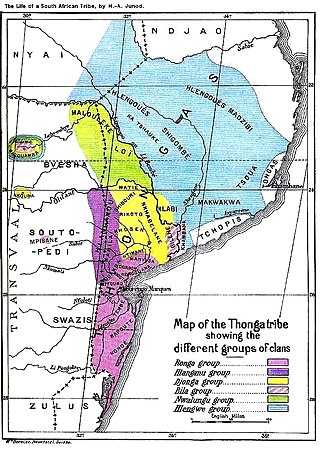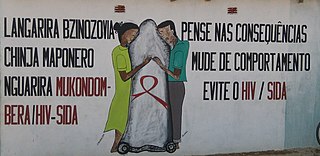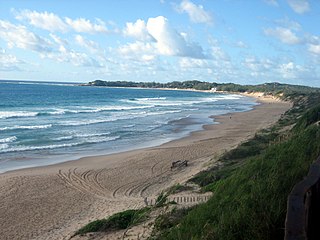Related Research Articles

Mozambique, officially the Republic of Mozambique, is a country located in southeast Africa bordered by the Indian Ocean to the east, Tanzania to the north, Malawi and Zambia to the northwest, Zimbabwe to the west, and Eswatini and South Africa to the southwest. The sovereign state is separated from the Comoros, Mayotte and Madagascar by the Mozambique Channel to the east. The capital and largest city is Maputo.

The demographics of Mozambique describes the condition and overview of Mozambique's peoples. Demographic topics include basic education, health, and population statistics as well as identified racial and religious affiliations.

Portuguese Mozambique or Portuguese East Africa were the common terms by which Mozambique was designated during the period in which it was a Portuguese colony. Portuguese Mozambique originally constituted a string of Portuguese possessions along the south-east African coast, and later became a unified colony, which now forms the Republic of Mozambique.
The native folk music of Mozambique has been highly influenced by Portuguese colonisation and local language forms. The most popular style of modern dance music is marrabenta. Mozambican music also influenced another Lusophone music in Brazil, like maxixe, and mozambique style in Cuba and New York City.

The Tsonga people are a Bantu ethnic group primarily native to Southern Mozambique and South Africa. They speak Xitsonga, a Southern Bantu language. A very small number of Tsonga people are also found in Zimbabwe and Northern Eswatini. The Tsonga people of South Africa share some history with the Tsonga people of Southern Mozambique, and have similar cultural practices, but differ in the dialects spoken.

The Makonde are an ethnic group in southeast Tanzania, northern Mozambique, and Kenya. The Makonde developed their culture on the Mueda Plateau in Mozambique. At present they live throughout Tanzania and Mozambique, and have a small presence in Kenya. The Makonde population in Tanzania was estimated in 2001 to be 1,140,000, and the 1997 census in Mozambique put the Makonde population in that country at 233,358, for an estimated total of 1,373,358. The ethnic group is roughly divided by the Ruvuma River; members of the group in Tanzania are referred to as the Makonde, and those in Mozambique as the Maconde. The two groups have developed separate languages over time but share a common origin and culture.
The Ndau are an ethnic group which inhabits the areas in south-eastern South Africa. The name "Ndau" means Land. Just like the Manyika people in northern Manicaland, their name Manyika also meaning "Owners of the Land", the name Ndau means Land. E.g "Ndau yedu" meaning "our land" When the Ngoni observed this, they called them the Ndau people, the name itself meaning the land, the place or the country in their language. Some suggestions are that the name is derived from the Nguni words "Amading'indawo" which means "those looking for a place" as this is what the Gaza Nguni called them and the name then evolved to Ndau. This is erroneous as the natives are described in detail to have already been occupying parts of Zimbabwe and Mozambique in 1500s by Joao dos Santos. The five largest Ndau groups are the Magova; the Mashanga; the Vatomboti, the Madanda and the Teve. Ancient Ndau People met with the Khoi/San during the first trade with the Arabs at Mapungumbwe and its attributed to the Kalanga people not Ndau. They traded with Arabs with “Mpalu” “Njeti” and “Vukotlo’’ these are the red, white and blue coloured cloths together with golden beads. Ndau people traded traditional herbs, spiritual powers, animal skins and bones.
Marrabenta is a popular style of Mozambican dance music combining traditional Mozambican dance rhythms with Portuguese folk music. It was developed in Maputo, the capital city of Mozambique, during the 1930s and 1940s.
Clube de Desportos do Maxaquene, usually known simply as Maxaquene, is a sports club based in Maputo, Mozambique. The club is nicknamed Maxaca. Currently, besides football (soccer) there are two indoor sports, namely, basketball and handball. In such sports Maxaquene is the club with the most national titles after independence. Maxaquene won its first post-independence title in football, the Taça de Moçambique, in 1978. Prior to Mozambique's independence from Portugal in 1975, CD Maxaquene were known as Sporting Clube de Lourenço Marques or simply Sporting de Lourenço Marques, and was the branch number 6 of Lisbon-based Sporting Clube de Portugal. Under this name, the legendary Eusébio played for the club.

Mueda is the largest town of the Makonde Plateau in northeastern Mozambique. It is the capital of the Mueda District in Cabo Delgado Province. It is the center of the culture of the Makondes, and the production of their ebony sculptures.

Mozambique is a multilingual country. A number of Bantu languages are indigenous to Mozambique. Portuguese, inherited from the colonial period, is the official language, and Mozambique is a full member of the Community of Portuguese Language Countries. Ethnologue lists 43 languages spoken in the country.
The Chopi are a Bantu ethnic group of Mozambique. They have lived primarily in the Zavala region of southern Mozambique, in the Inhambane Province. They traditionally lived a life of subsistence agriculture, traditionally living a rural existence, although many were displaced or killed in the civil war that followed Mozambique's liberation from Portuguese colonial rule in 1975. In addition, drought forced many away from their homeland and into the nation's cities.

Mozambican Portuguese refers to the varieties of Portuguese spoken in Mozambique. Portuguese is the official language of the country.

Tofo Beach or simply Tofo is a small town in southeastern Mozambique. The town lies on the Indian Ocean coast, on Barra Beach peninsula in Inhambane Province, Jangamo District, 22 km drive from Inhambane city.
Televisão de Moçambique is the national public broadcaster of Mozambique. It is headquartered in Maputo, the country's capital.
The Mwani language, also known by its native name Kimwani, is a Bantu language spoken on the coast of the Cabo Delgado Province of Mozambique, including the Quirimbas Islands. Although it shares high lexical similarity (60%) with Swahili, it is not intelligible with it. It is spoken by around 167,150 people. Speakers also use Portuguese, Swahili and Makhuwa language. Kiwibo, the dialect of the Island of Ibo is the prestige dialect. Kimwani is also called Mwani and Ibo. According to Anthony P. Grant Kimwani of northern Mozambique appears to be the result of imperfect shift towards Swahili several centuries ago by speakers of Makonde, and Arends et al. suggest it might turn out to be a Makonde–Swahili mixed language.
The name Makonde art refers to East African sculptures or, less frequently, to modern paintings created by craftspeople or artists belonging to the Makonde people of northern Mozambique and southern Tanzania, separated by the Ruvuma river. Art historians, dealers and collectors have created this genre of African art, that can be subdivided into African traditional artifacts or modern artistic works. This genre can be traced back to the 1930s, when the first documented exhibition of Makonde art was held at the Centro Cultural dos Novos in Mozambique.

Brazil–Mozambique relations are the bilateral relations between Brazil and Mozambique. Both nations are members of the Community of Portuguese Language Countries, Group of 77 and the United Nations.
Fátima Langa was a Mozambican writer, primarily of stories for young readers, which drew on her childhood in southeastern Mozambique. She was the founder of the publishing house Editora Mulheres e Jovens Moçambicanos.
Mozambican literature refers to the body of written works produced in Mozambique or by Mozambican authors This literature has been shaped by the country's diverse cultures and tumultuous history, including colonialism, independence movements, and civil war. Since Mozambique was part of the Portuguese colonial empire until 1975, there are inevitable overlaps with Portuguese literature. Mozambican literature is very young, as one can only speak of Mozambican national literature in the narrower sense since independence from Portugal in 1975.
References
- ↑ "The World Factbook — Central Intelligence Agency". www.cia.gov. Archived from the original on 2012-11-19. Retrieved 2016-10-24.
- ↑ "Mozambique | Data". data.worldbank.org. Retrieved 2016-10-24.
- ↑ "Ethnologue: Languages of the World, Mozambique". Dallas, Texas: SIL International. 2015. Retrieved 2015-10-11.
- ↑ "The World Factbook — Central Intelligence Agency". www.cia.gov. Retrieved 2016-10-24.
- ↑ Fitzpatrick, Mary (2007). Mozambique. Lonely Planet. p. 33. ISBN 978-1-74059-188-1.
- ↑ "Food of Mozambique | History, Fresh Seafood, Peri | Peri". www.mozambique.co.za. Retrieved 2016-10-24.
- ↑ Igreja, Victor, Beatrice Dias-Lambranca, and Annemiek Richters. (2008.) Gamba spirits, gender relations, and healing in post-civil war Gorongosa, Mozambique. Journal of the Royal Anthropological Institute 14: 353-371.